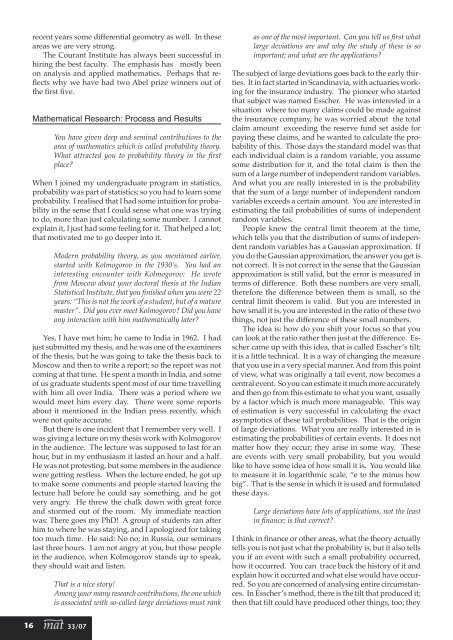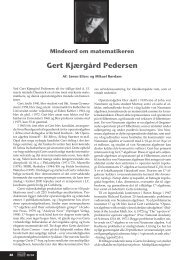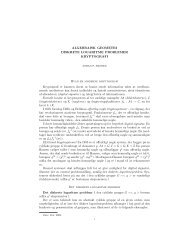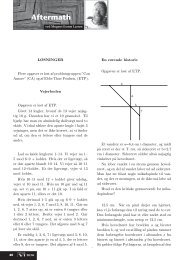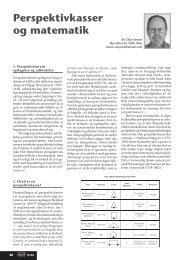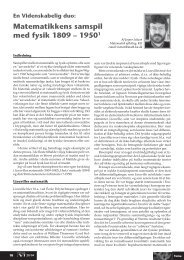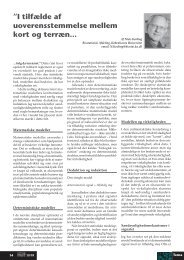TEMA - Matilde - Dansk Matematisk Forening
TEMA - Matilde - Dansk Matematisk Forening
TEMA - Matilde - Dansk Matematisk Forening
You also want an ePaper? Increase the reach of your titles
YUMPU automatically turns print PDFs into web optimized ePapers that Google loves.
ecent years some differential geometry as well. In these<br />
areas we are very strong.<br />
The Courant Institute has always been successful in<br />
hiring the best faculty. The emphasis has mostly been<br />
on analysis and applied mathematics. Perhaps that reflects<br />
why we have had two Abel prize winners out of<br />
the first five.<br />
Mathematical Research: Process and Results<br />
You have given deep and seminal contributions to the<br />
area of mathematics which is called probability theory.<br />
What attracted you to probability theory in the first<br />
place?<br />
When I joined my undergraduate program in statistics,<br />
probability was part of statistics; so you had to learn some<br />
probability. I realised that I had some intuition for probability<br />
in the sense that I could sense what one was trying<br />
to do, more than just calculating some number. I cannot<br />
explain it, I just had some feeling for it. That helped a lot;<br />
that motivated me to go deeper into it.<br />
Modern probability theory, as you mentioned earlier,<br />
started with Kolmogorov in the 1930’s. You had an<br />
interesting encounter with Kolmogorov: He wrote<br />
from Moscow about your doctoral thesis at the Indian<br />
Statistical Institute, that you finished when you were 22<br />
years: “This is not the work of a student, but of a mature<br />
master”. Did you ever meet Kolmogorov? Did you have<br />
any interaction with him mathematically later?<br />
Yes, I have met him; he came to India in 1962. I had<br />
just submitted my thesis, and he was one of the examiners<br />
of the thesis, but he was going to take the thesis back to<br />
Moscow and then to write a report; so the report was not<br />
coming at that time. He spent a month in India, and some<br />
of us graduate students spent most of our time travelling<br />
with him all over India. There was a period where we<br />
would meet him every day. There were some reports<br />
about it mentioned in the Indian press recently, which<br />
were not quite accurate.<br />
But there is one incident that I remember very well. I<br />
was giving a lecture on my thesis work with Kolmogorov<br />
in the audience. The lecture was supposed to last for an<br />
hour, but in my enthusiasm it lasted an hour and a half.<br />
He was not protesting, but some members in the audience<br />
were getting restless. When the lecture ended, he got up<br />
to make some comments and people started leaving the<br />
lecture hall before he could say something, and he got<br />
very angry. He threw the chalk down with great force<br />
and stormed out of the room. My immediate reaction<br />
was: There goes my PhD! A group of students ran after<br />
him to where he was staying, and I apologized for taking<br />
too much time. He said: No no; in Russia, our seminars<br />
last three hours. I am not angry at you, but those people<br />
in the audience, when Kolmogorov stands up to speak,<br />
they should wait and listen.<br />
That is a nice story!<br />
Among your many research contributions, the one which<br />
is associated with so-called large deviations must rank<br />
16 33/07<br />
as one of the most important. Can you tell us first what<br />
large deviations are and why the study of these is so<br />
important; and what are the applications?<br />
The subject of large deviations goes back to the early thirties.<br />
It in fact started in Scandinavia, with actuaries working<br />
for the insurance industry. The pioneer who started<br />
that subject was named Esscher. He was interested in a<br />
situation where too many claims could be made against<br />
the insurance company, he was worried about the total<br />
claim amount exceeding the reserve fund set aside for<br />
paying these claims, and he wanted to calculate the probability<br />
of this. Those days the standard model was that<br />
each individual claim is a random variable, you assume<br />
some distribution for it, and the total claim is then the<br />
sum of a large number of independent random variables.<br />
And what you are really interested in is the probability<br />
that the sum of a large number of independent random<br />
variables exceeds a certain amount. You are interested in<br />
estimating the tail probabilities of sums of independent<br />
random variables.<br />
People knew the central limit theorem at the time,<br />
which tells you that the distribution of sums of independent<br />
random variables has a Gaussian approximation. If<br />
you do the Gaussian approximation, the answer you get is<br />
not correct. It is not correct in the sense that the Gaussian<br />
approximation is still valid, but the error is measured in<br />
terms of difference. Both these numbers are very small,<br />
therefore the difference between them is small, so the<br />
central limit theorem is valid. But you are interested in<br />
how small it is, you are interested in the ratio of these two<br />
things, not just the difference of these small numbers.<br />
The idea is: how do you shift your focus so that you<br />
can look at the ratio rather then just at the difference. Esscher<br />
came up with this idea, that is called Esscher’s tilt;<br />
it is a little technical. It is a way of changing the measure<br />
that you use in a very special manner. And from this point<br />
of view, what was originally a tail event, now becomes a<br />
central event. So you can estimate it much more accurately<br />
and then go from this estimate to what you want, usually<br />
by a factor which is much more manageable. This way<br />
of estimation is very successful in calculating the exact<br />
asymptotics of these tail probabilities. That is the origin<br />
of large deviations. What you are really interested in is<br />
estimating the probabilities of certain events. It does not<br />
matter how they occur; they arise in some way. These<br />
are events with very small probability, but you would<br />
like to have some idea of how small it is. You would like<br />
to measure it in logarithmic scale, “e to the minus how<br />
big”. That is the sense in which it is used and formulated<br />
these days.<br />
Large deviations have lots of applications, not the least<br />
in finance; is that correct?<br />
I think in finance or other areas, what the theory actually<br />
tells you is not just what the probability is, but it also tells<br />
you if an event with such a small probability occurred,<br />
how it occurred. You can trace back the history of it and<br />
explain how it occurred and what else would have occurred.<br />
So you are concerned of analysing entire circumstances.<br />
In Esscher’s method, there is the tilt that produced it;<br />
then that tilt could have produced other things, too; they


